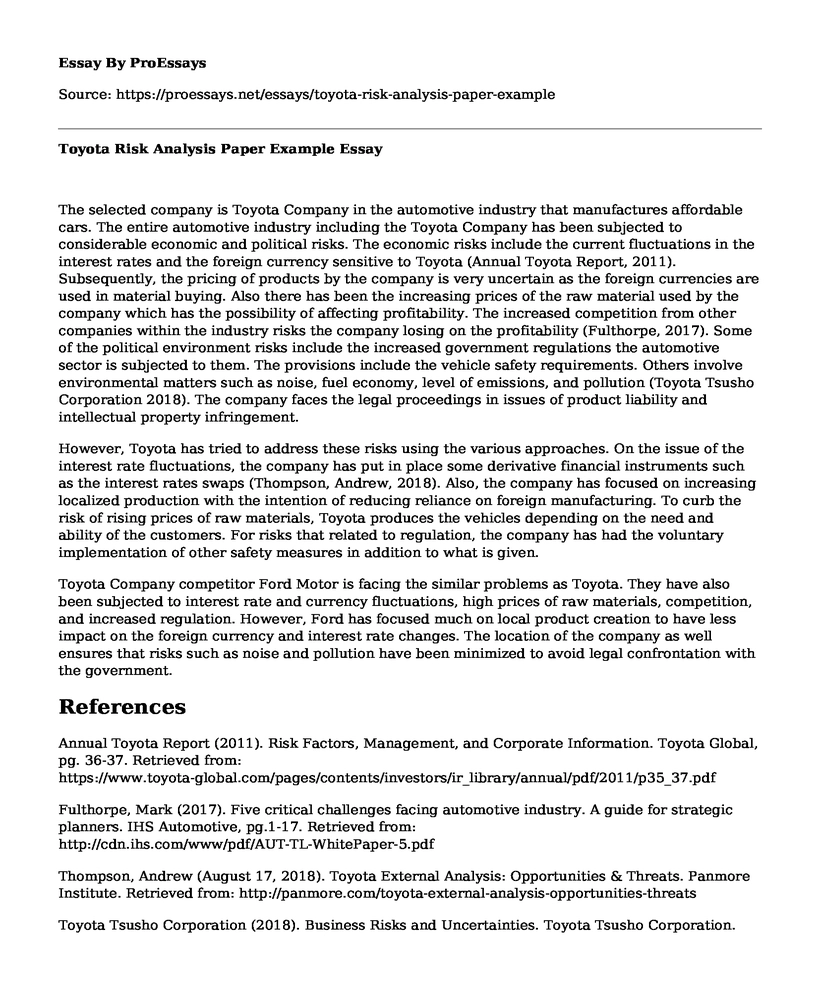The selected company is Toyota Company in the automotive industry that manufactures affordable cars. The entire automotive industry including the Toyota Company has been subjected to considerable economic and political risks. The economic risks include the current fluctuations in the interest rates and the foreign currency sensitive to Toyota (Annual Toyota Report, 2011). Subsequently, the pricing of products by the company is very uncertain as the foreign currencies are used in material buying. Also there has been the increasing prices of the raw material used by the company which has the possibility of affecting profitability. The increased competition from other companies within the industry risks the company losing on the profitability (Fulthorpe, 2017). Some of the political environment risks include the increased government regulations the automotive sector is subjected to them. The provisions include the vehicle safety requirements. Others involve environmental matters such as noise, fuel economy, level of emissions, and pollution (Toyota Tsusho Corporation 2018). The company faces the legal proceedings in issues of product liability and intellectual property infringement.
However, Toyota has tried to address these risks using the various approaches. On the issue of the interest rate fluctuations, the company has put in place some derivative financial instruments such as the interest rates swaps (Thompson, Andrew, 2018). Also, the company has focused on increasing localized production with the intention of reducing reliance on foreign manufacturing. To curb the risk of rising prices of raw materials, Toyota produces the vehicles depending on the need and ability of the customers. For risks that related to regulation, the company has had the voluntary implementation of other safety measures in addition to what is given.
Toyota Company competitor Ford Motor is facing the similar problems as Toyota. They have also been subjected to interest rate and currency fluctuations, high prices of raw materials, competition, and increased regulation. However, Ford has focused much on local product creation to have less impact on the foreign currency and interest rate changes. The location of the company as well ensures that risks such as noise and pollution have been minimized to avoid legal confrontation with the government.
References
Annual Toyota Report (2011). Risk Factors, Management, and Corporate Information. Toyota Global, pg. 36-37. Retrieved from: https://www.toyota-global.com/pages/contents/investors/ir_library/annual/pdf/2011/p35_37.pdf
Fulthorpe, Mark (2017). Five critical challenges facing automotive industry. A guide for strategic planners. IHS Automotive, pg.1-17. Retrieved from: http://cdn.ihs.com/www/pdf/AUT-TL-WhitePaper-5.pdf
Thompson, Andrew (August 17, 2018). Toyota External Analysis: Opportunities & Threats. Panmore Institute. Retrieved from: http://panmore.com/toyota-external-analysis-opportunities-threats
Toyota Tsusho Corporation (2018). Business Risks and Uncertainties. Toyota Tsusho Corporation. Retrieved from: https://www.toyota-tsusho.com/english/ir/management/risk.html
Cite this page
Toyota Risk Analysis Paper Example. (2022, Sep 13). Retrieved from https://proessays.net/essays/toyota-risk-analysis-paper-example
If you are the original author of this essay and no longer wish to have it published on the ProEssays website, please click below to request its removal:
- Hirschman's Theory of Exit, Voice, and Loyalty Versus Hoffer's Analysis of "True Believers"
- Essay Sample on Virtual Teams and Robotics
- The Readiness of Young Learners to Become Leaders - Paper Sample
- Advantages and Disadvantages of Group Decisions Making Essay
- Meals on Wheels Organization Planning Paper Example
- How to Apply Motivation, Leadership Skills in Workplace Essay Example
- Essay Example on Differentiation: A Vital Strategy for Market Leadership







